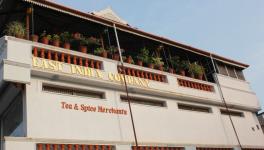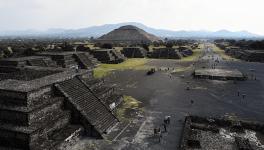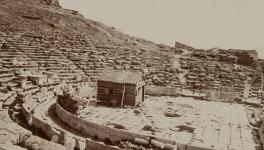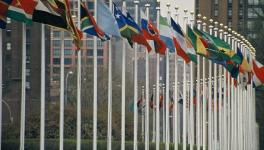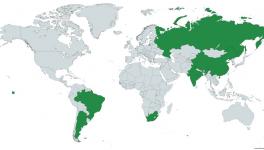Indigenous Agriculture in North America & American Genocide

Representational Image. Image Courtesy: Wikimedia Commons
A recent paper in the magazine, Science, addresses an intriguing question: Did North America have settled agriculture before the arrival of Europeans? Or were the people in North America still in the hunter-gatherer stage, unlike Mesoamericans, who had advanced civilisations, such as the Mayans, Aztecs, and the Incas?
The answer is that it did have significant agriculture, which "disappeared" only after their encounters with the invading Europeans settling in their lands. The use of Lidar tools in mapping areas of Michigan associated with the Menominee people recently shows that settled agriculture existed not only in the lower latitudes —modern Mexico—but even in the much harsher north near the Great Lakes bordering Canada.
Recent advances in the use of Lidar tools—particularly drones, low-cost and low-weight Lidar sensors, and ground penetrating radar make it easier to survey both surface and subsurface features. This has led to significant advances in our understanding of the past.
This article looks at how the new historical knowledge about agriculture in North America impacts the debate on how the indigenous people in North America died in such large numbers. Was it genocide, or was their weak immune system to blame? American historians today increasingly, though reluctantly, accept that disease, coupled with direct violence—mass killings and uprooting people from their ancestral lands—caused the massive population decline of the indigenous people.
A significant body of opinion, expressed particularly in popular books, e.g, Jared Diamond's Guns, Germs, and Steel, of why the indigenous people of the Americas died in such large numbers is ascribed primarily to their lack of immunity to the disease brought to the New World by the Europeans. This view airbrushes out of history their repeated massacres, taking away their lands and means of sustenance, and continuous displacement, etc. It makes the drastic fall of their population just an unfortunate accident of history: "The microbes did it, not us". As we shall see, this not only contradicts what we know about history, but also about epidemics and immunity: the silent battle between germs and our immune system.
It is here that the actual history of agriculture in the USA becomes important. A recent Lidar survey brings out the extent of Menominee settlements and their agriculture practices in the Great Lakes area of Michigan. We also know that historically, the Menominee occupied a much larger territory, estimated at 10 million acres. Treaties with the US government reduced their land base to only 2.5% of their original lands, along with a sharp drop in their population.
The earlier arguments against settled agriculture in the North American plains have been the absence of the plough. We now know that the Menominee "... practised permanent, intensive cropping...Indigenous farmers in North America also grew a highly productive cereal grain, maize, uniquely suited to no-plough conditions."
We also have a record of settled agriculture from 600 to 1600 from sites, such as Cahokia and Moundville, both located in the Mississippi River Valley and south of the Menominee in the Great Lakes area. This means that agriculture could be significantly higher than what we have estimated till now. With a much larger spread of agriculture and a higher productivity of settled agriculture than hunting/gathering, the population of the North America (the US and Canada, not counting Mexico as it was a part of Meso-America) would then be at least 10 million if not higher, given the current range of estimations being 1-18 million.
What was the extent of the loss of the indigenous population in the North? By all estimates, it was between 95% and 98% of their existing population. A recent research paper—Earth System Impacts of the European Arrival and Great Dying in the Americas after 1492—by four geographers from University College London has used the fall in carbon emissions in this period, the 16th and 17th centuries, as a proxy for population.
The drop in CO2 levels during this period is shown from ice cores from Antarctica and therefore methodologically independent of other estimates of carbon emissions based on historical data. It shows that the CO2 levels in this period dropped 7-10 ppm, most probably due to the forest regrowth in the Americas. To quote, "the global carbon budget of the 1500s cannot be balanced until large-scale vegetation regeneration in the Americas is included. The Great Dying of the Indigenous Peoples of the Americas resulted in a human-driven global impact on the Earth system in the two centuries prior to the Industrial Revolution."
So, how much was this from outright violence—wars, mass killings, enslaving population, and working them to death, forcing them to leave their lands not once but again and again—and how much was new diseases for which the indigenous people had no immunity? The germ theory of disease and large-scale deaths has an obvious attraction for those who became the owners of the land after the "removal" of the original settlers.
If the indigenous people had no immunity to the European pathogens/germs, then their decimation can be blamed on nature and not the colonisers. That the indigenous people were violently uprooted again and again, enslaved, and their lands taken away is then only incidental to their decline.
The history of the violence that the European settlers inflicted is now well known, starting with Bartolomé de las Casas, a Spanish catholic priest who chronicled Columbus's brutality on the Arawak people in the Caribbean—A Short Account of the Destruction of the Indies—became an outspoken critic of Spanish colonial violence. His and various other contemporary accounts make clear that slavery, inhuman conditions of their labour and large-scale violence led to the sharp decline of the native Arawak/Taino population in the Caribbean.
In North America, the colonisers, as they moved westward, took away the lands of the indigenous peoples, confining them to "reservations", and forcing them over and over again either to move from such reservations to other less hospitable lands, or confining them to ever-decreasing areas. And it was always accompanied by violence and massacres, in which we have detailed evidence of the "Indian Wars": "slaughter of Cheyennes at Sand Creek (1864) and the army's slaughter of Shoshones at Bear River (1863), Blackfeet on the Marias River (1870), and Lakotas at Wounded Knee (1890)" (Wikipedia: List of Indian massacres in North America).
Recent scholarly works such as American Holocaust: The Conquest of the New World by David Stannard, A Pest in the Land: New World Epidemics in a New Perspective by Suzanne Austin Alchon, American Indian Holocaust and Survival: A Population History Since 1492 by Russell Thornton and Beyond Germs: Native Depopulation in North America by Catherine M. Cameron, Paul Kelton, and Alan C. Swedlund, all make clear that germs in the old world and the new world behaved in the same way as did our immune systems.
New diseases emerge, causing epidemics that result in significant mortality, and populations rebound over time. If we encounter a new pathogen—more accurately, a new variant of an existing pathogen—we become infected in large numbers, some die, and the rest develop immunity. Whether it was the Black Death in medieval times or COVID-19 in more recent times, the battle between our immune system, particularly our acquired immunity, behaves in very similar ways.
Historical records in the Americas also bear this out, as we can see from the new accounts of Stannard, Alchon and others above. The only major difference in epidemiology is our understanding of how diseases spread: through waterborne or airborne transmission, and the use of medicines and vaccines. Not the myth that some populations —the Europeans, as compared to the indigenous American population—had a more developed immune system.
To sum up, I will quote from Virgin Soils Revisited by David S. Jones in The William and Mary Quarterly, Oct., 2003, "It could well be that the epidemics among American Indians, despite their unusual severity, were caused by the same forces of poverty, social stress, and environmental vulnerability that cause epidemics in all other times and places...If they attribute depopulation to irresistible genetic and microbial forces, they risk being interpreted as supporting racial theories of historical development. Instead, they must acknowledge the ways in which multiple factors, especially social forces and human agency, shaped the epidemics of encounter and colonization."
So why does germ theory still hold such sway in popular literature as well as serious historical accounts? The answer is that it absolves the current beneficiaries of such past genocide, a process which was openly proclaimed from the post-1492 era to relatively recent times, but is now a matter of embarrassment.
Statements like "Only good Indian is a Dead Indian", "Indians and wolves are both beasts of prey, tho' they differ in shape", "Established in the midst of another and a superior race...they must necessarily yield to the force of circumstances and ere long disappear" are not statements made by marginal figures. They were from Philip Sheridan, the Commander-in-Chief of the US Armed Forces and a highly decorated hero of the American Civil War, and two illustrious presidents of the US: George Washington and Thomas Jefferson. What was easy to say in a period in which racial violence, slavery and genocide were taken for granted by the white colonisers, now masquerade as science.
Get the latest reports & analysis with people's perspective on Protests, movements & deep analytical videos, discussions of the current affairs in your Telegram app. Subscribe to NewsClick's Telegram channel & get Real-Time updates on stories, as they get published on our website.









